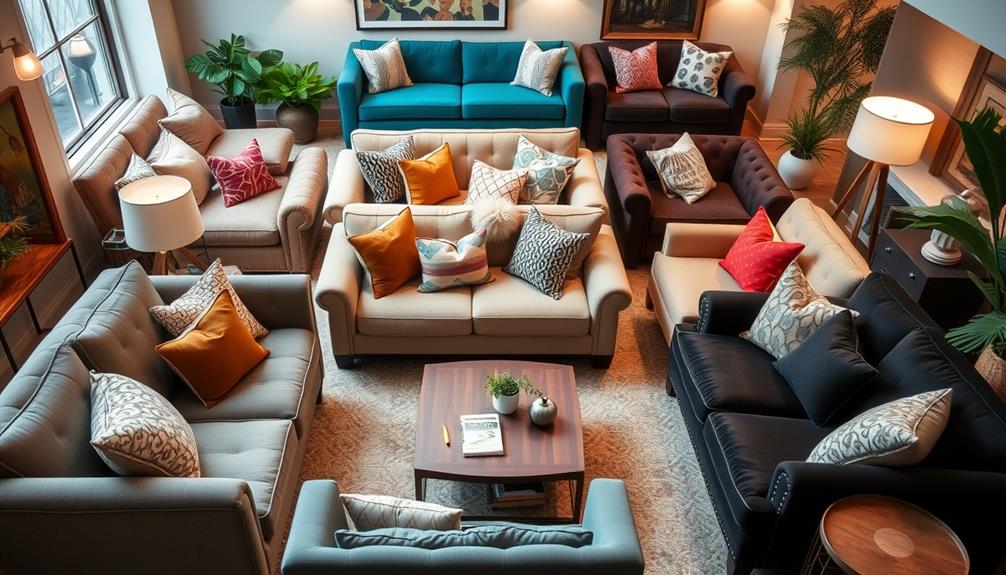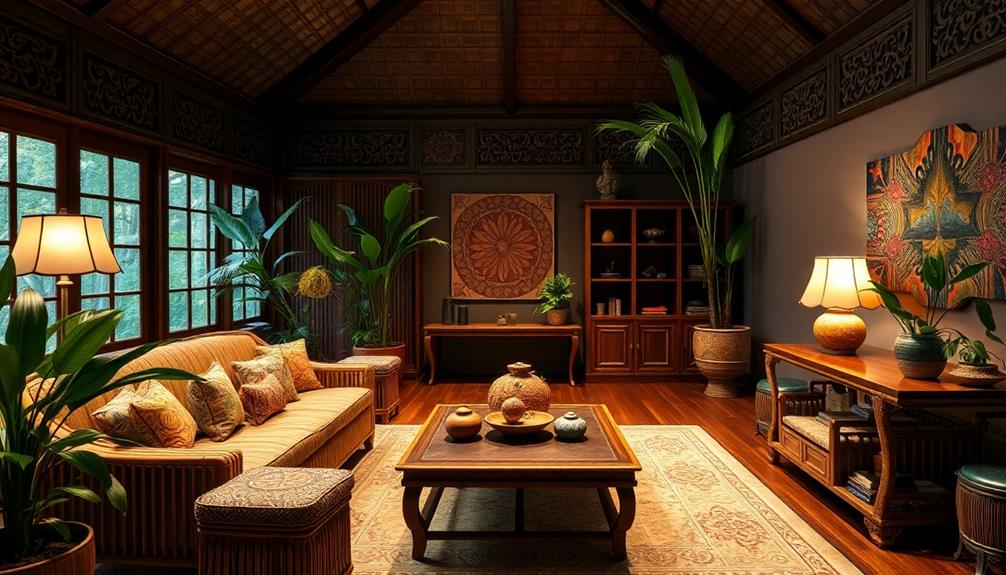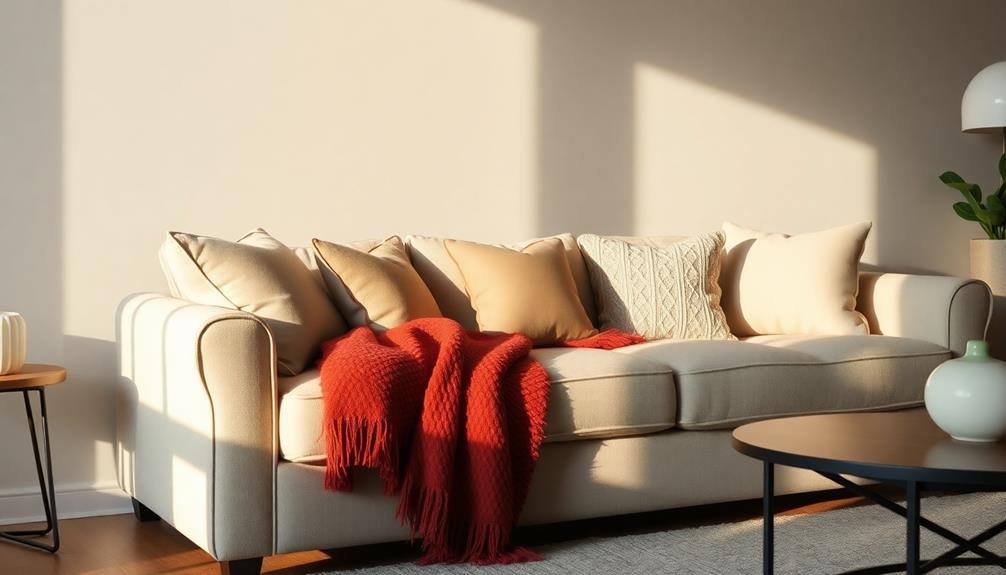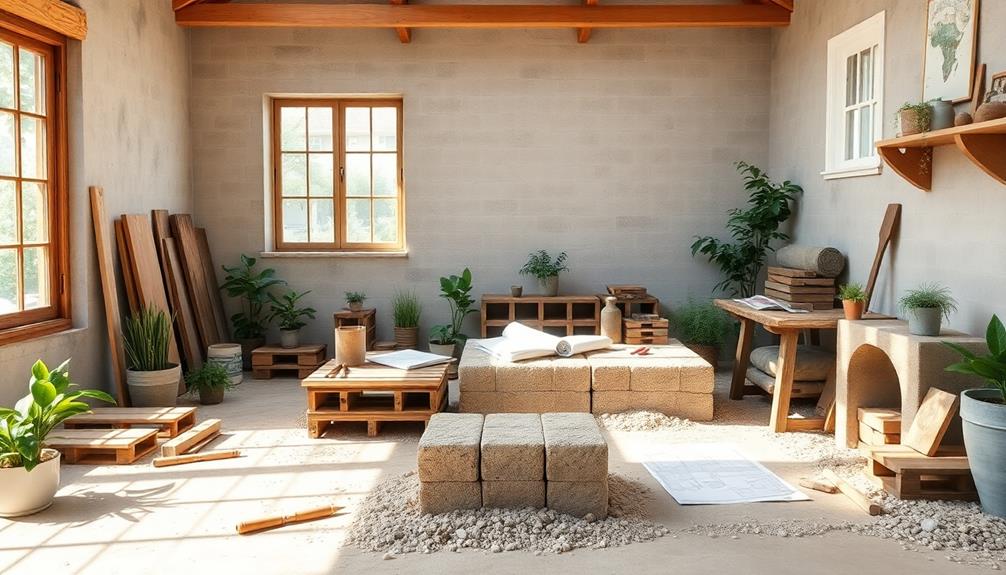When selecting a sofa, there are several important factors to consider. Start by determining the type – whether traditional, sectional, sleeper, or loveseat – based on your space and requirements. Then, think about style and fabric; it’s important to choose something that complements your decor and suits your lifestyle, especially in terms of durability and maintenance. Don’t overlook the comfort level provided by the fill; foam offers support while down adds a touch of luxury. Measure your room and try out sofas in-person for comfort. Lastly, be sure to understand the return policies and warranties. This comprehensive approach will help you find the perfect sofa for your home. You can also explore additional tips to streamline your purchasing experience. Additionally, consider the color and pattern of the fabric, as well as any throw pillow fabric options that may be available to match your sofa. This allows you to personalize your furniture. By considering all of these factors, you can make a well-informed decision when selecting a sofa for your home.
Key Takeaways
- Identify the type of sofa that best suits your space, such as traditional, sectional, sleeper, or loveseat.
- Consider the sofa's style and design to ensure it complements your home's aesthetic.
- Evaluate fabric options based on durability, maintenance, and lifestyle needs, choosing stain-resistant or easy-to-clean materials if necessary.
- Test the sofa in-store for comfort, paying attention to cushion types, height, and depth to meet your personal preferences.
- Measure your space accurately, ensuring the sofa fits through doorways and allows for comfortable movement around the room.
Types of Sofas
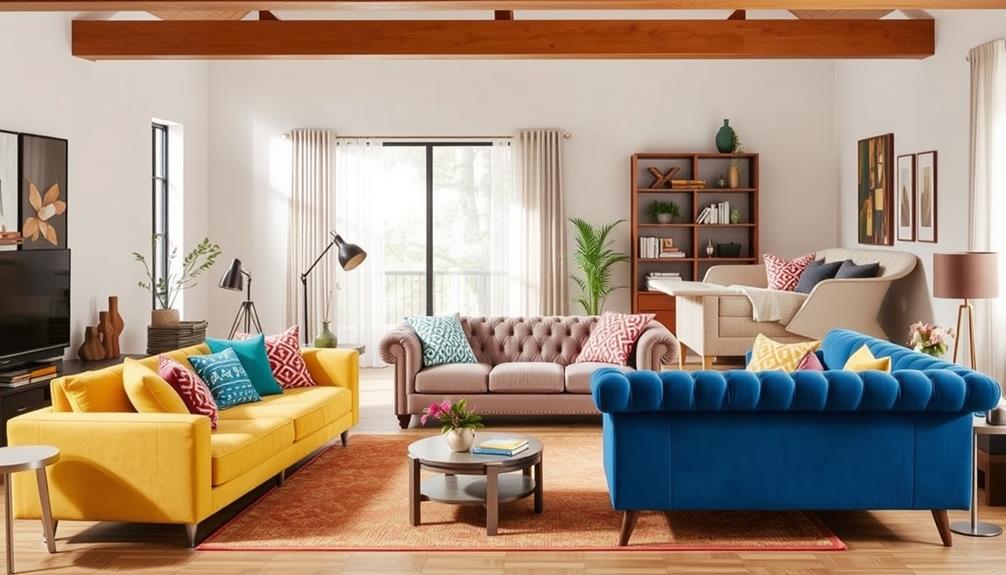
When it comes to choosing a sofa, understanding the different types available can really help you narrow down your options. You'll find several types of sofas, each serving a unique purpose.
Traditional sofas are a classic choice, typically designed as standard three-seaters. They fit well in various home styles, providing ample seating for family and friends. Additionally, selecting the right sofa can be part of a broader financial planning strategy, as creating a personal budget guarantees you can afford the furniture that complements your home.
If you have a larger living area, consider sectional sofas. These sofas can be customized in arrangement and shape, making them perfect for maximizing space and accommodating different seating needs.
For those tight on space, sleeper sofas are a practical option since they convert from a sofa to a bed, ideal for guests.
If you're looking for something cozier, loveseats seat two people comfortably and work well in small spaces or as additional seating in larger rooms.
Choosing Your Sofa Style
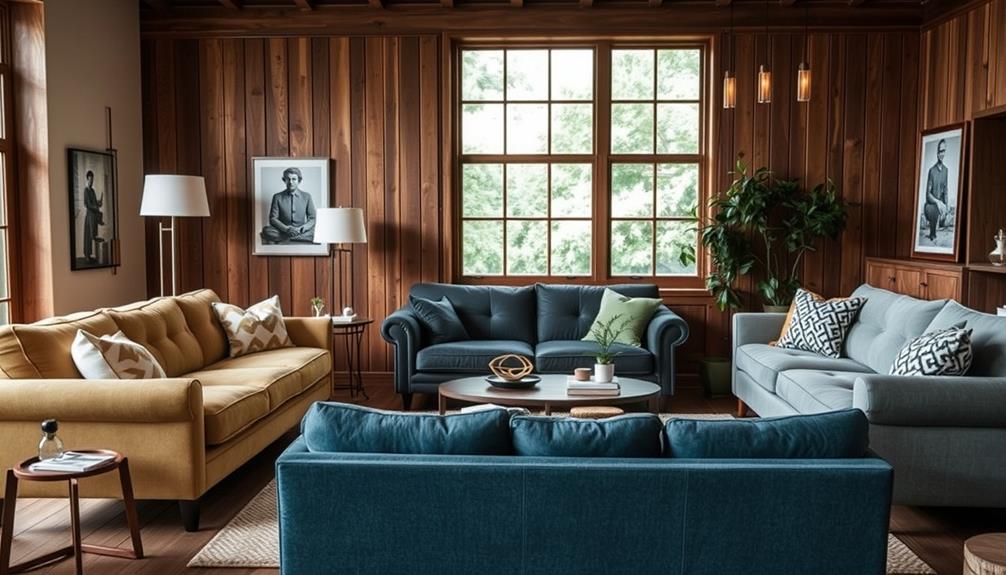
Choosing Your Sofa Style
A wide range of sofa styles is available, allowing you to find the perfect match for your home's aesthetic. Consider whether your space leans towards formal, casual, modern, or eclectic designs. This guarantees harmony in your interior design.
Traditional sofas, like the Lawson or English Roll Arm styles, offer a timeless look that complements classic decor. If you prefer a contemporary feel, Midcentury Modern designs feature clean lines and tapered legs that add a sleek touch. Understanding your personal influences can also play a significant role in narrowing down your choices, as personal influences shape individual design styles.
You might also explore adaptable designs, which blend traditional and modern aesthetics. These versatile options fit various home styles and preferences, making them a great choice if you enjoy mixing elements.
Don't forget to pay attention to design extras like welting and nailheads, which can enhance the visual appeal of your chosen sofa style.
Evaluating Fabric Options
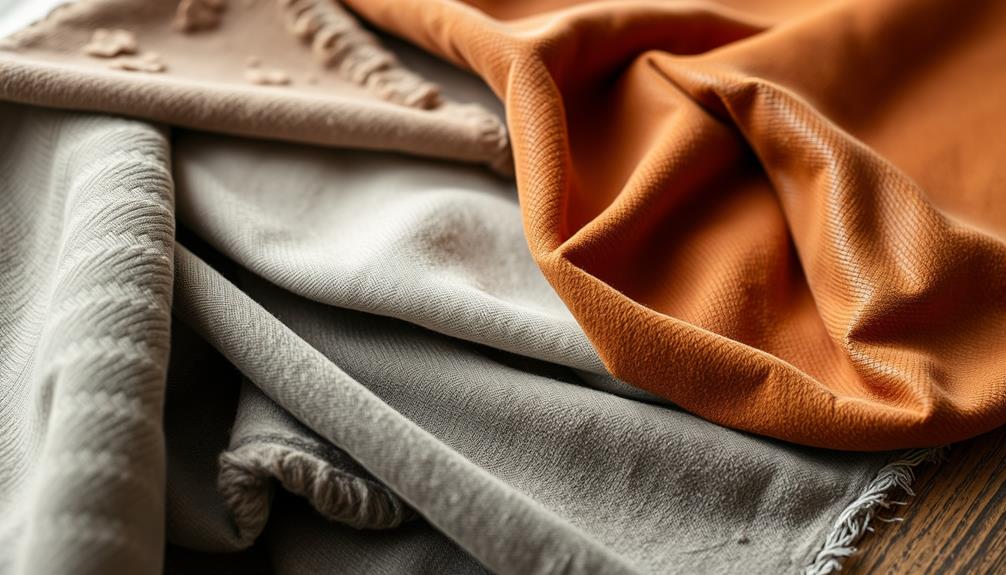
When you're picking a sofa fabric, think about how it'll hold up over time and how easy it'll be to clean.
Performance fabrics are great for resisting stains, while natural fibers like linen and cotton can look beautiful but might need more care.
Additionally, consider how the fabric choice might affect the overall comfort and aesthetic of your living space, as certain textures can enhance warmth and style.
Don't forget to check the Martindale rub test results to guarantee your choice can withstand daily use without wearing out quickly.
butter plays a role in traditional baking across various cultures
Fabric Durability Considerations
Evaluating fabric options for your sofa involves understanding durability to confirm it meets your lifestyle needs. If you have kids or pets, reflect on performance fabrics. These are designed to resist stains and spills, making them perfect for high-traffic areas.
For households with pets, you might also want to think about fabrics that can withstand high suction power for effective cleaning, similar to the features found in best vacuums for pet hair.
On the other hand, leather offers a sleek look and is easy to clean, but it can be prone to scratches. Its durability largely depends on the specific type and treatment of the leather.
Natural fibers like cotton and linen feel great but tend to wear out faster, especially in busy households, so think carefully about their longevity.
Wool blends strike a balance between comfort and durability, as they can effectively hide stains. However, they do require more maintenance to keep them looking fresh.
When evaluating fabric durability, aim for options that can withstand at least 25,000 rubs on the Martindale rub test. This level of wear resistance confirms your sofa can handle everyday use without showing significant wear and tear.
Ultimately, choose a fabric that aligns with your lifestyle while providing both comfort and longevity.
Maintenance and Cleaning Options
Maintaining your sofa's appearance and longevity starts with choosing the right cleaning options. When selecting a fabric, consider performance fabrics that are stain-resistant and easy to clean, especially if you have kids or pets. Slip-covered sofas are another great choice, as they allow for easy removal and washing of fabric covers, simplifying maintenance.
To help you navigate your options, here's a quick comparison:
| Fabric Type | Maintenance and Cleaning Options |
|---|---|
| Performance Fabrics | Stain-resistant, easy to wipe clean |
| Slip-Covered | Removable covers, machine washable |
| Leather | Easy to clean; requires occasional conditioning |
| Synthetic (Polyester) | Affordable, durable, and easy to clean |
Evaluate durability using the Martindale rub test; a rating of 25,000 rubs or more signifies resilience. For high-traffic areas, synthetic fabrics strike the perfect balance of affordability and durability. If you prefer leather, remember it's generally easier to maintain than fabric but may need occasional care to prevent scratches. Choose wisely to guarantee your sofa remains stylish and functional for years to come!
Understanding Sofa Fill
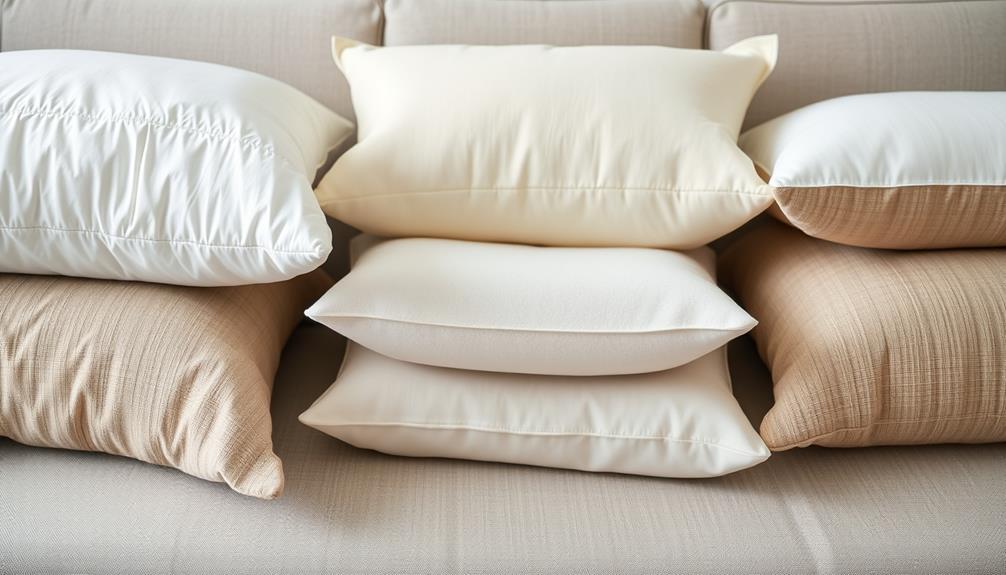
Choosing the right sofa fill can make all the difference in your comfort and overall satisfaction. When considering your options, it's vital to understand how different fills affect both feel and durability.
For example, opting for a fill that's easy to maintain can save you time and effort in the long run, particularly for busy households or best options for dust removal.
Here are some common types of sofa fill to think about:
- Foam Fill: Offers firm support and resilience, perfect for high-traffic areas where everyday use is a must.
- Down Fill: Provides a luxurious, plush feel, but requires regular fluffing to maintain shape and can shed over time.
- Combination Fill: This blends a foam core with a down wrap, delivering a balance of support and softness for those who want the best of both worlds.
- Durability: Foam typically lasts longer than down, so consider how much use your sofa will get when selecting the fill.
Your comfort preference is important, too. Some folks love the firmness of foam, while others prefer the plushness of down.
Ultimately, think about how you use your sofa and what feel you desire to make the best choice for your space.
Important Design Extras
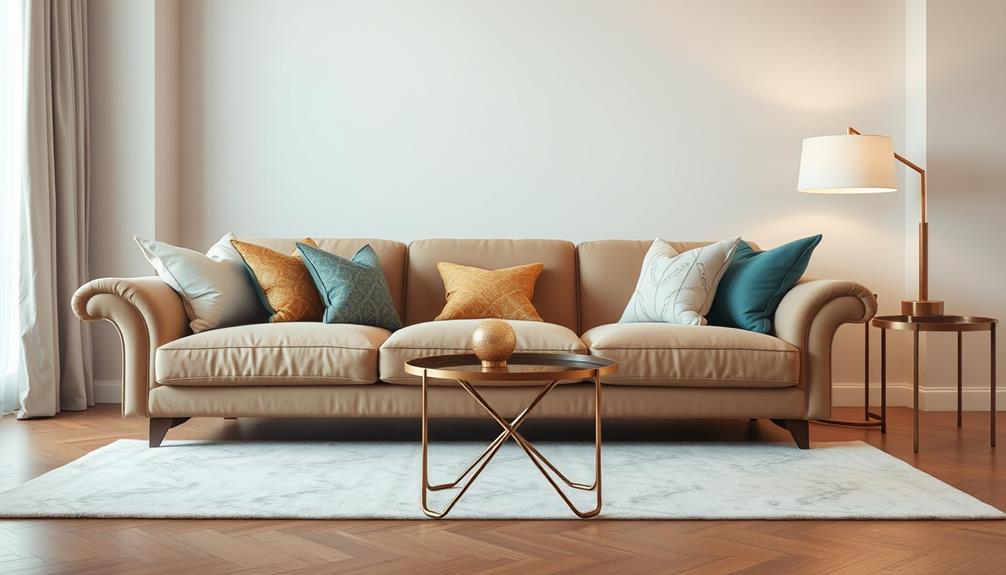
When it comes to enhancing the visual appeal of your sofa, significant design extras can make a notable difference. Welting, for instance, adds piping along the edges of the cushions and frames, giving your sofa a tailored look and elevating its sophistication.
Additionally, consider using materials that align with the Modern Farmhouse Decor Trends (2024) to create a cohesive aesthetic. Nailheads can also be a striking addition; these metallic trims serve as decorative accents that can complement various design styles, enhancing your sofa's overall aesthetic.
Don't overlook the impact of leg types, either. Whether you choose bun feet, straight legs, or turned legs, the right choice can align your sofa with a specific design theme, further enhancing its visual appeal.
It's essential to guarantee that these design extras maintain style consistency with your chosen sofa style. If your sofa features a modern design, for example, opt for sleek, minimalistic accents.
Comfort Considerations
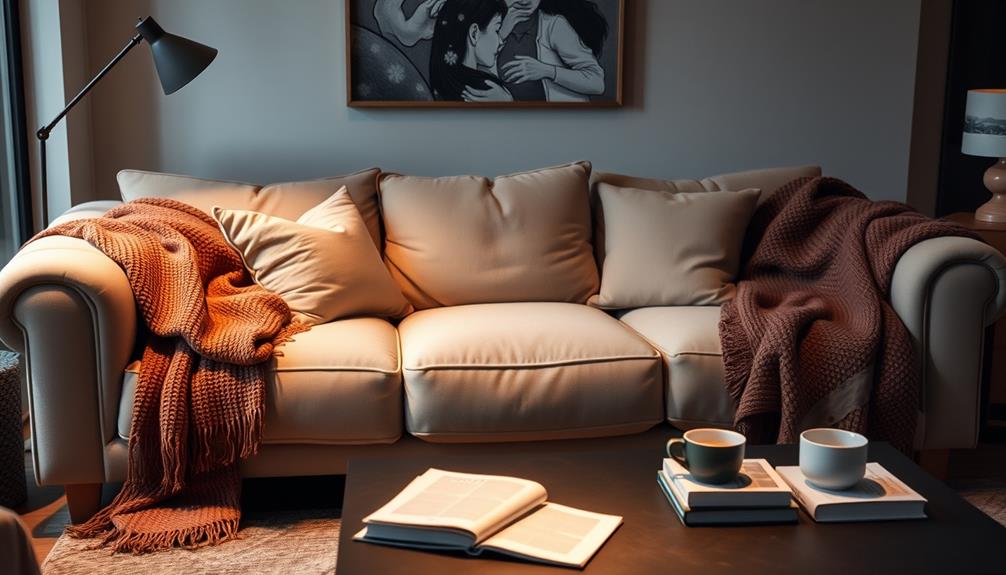
Comfort is a crucial factor when selecting a sofa, as it directly impacts your relaxation and enjoyment. When considering comfort, pay attention to various elements that affect your overall experience, similar to how one would choose the right cold medications overview for effective relief during a cold.
Here are some key points to keep in mind:
- Cushion Types: Test different cushion styles, like box, bullnose, and button cushions, to find what feels best for you.
- Height and Depth: Consider the height and depth of the sofa; these dimensions play an important role in how comfortable you'll feel while sitting.
- Cushion Count: Decide between single or multiple cushions; multiple cushions offer flexibility and ease of cleaning, while a single cushion can provide a sleek look.
- Personal Preferences: Evaluate your comfort preferences—do you prefer plush cushioning or a firmer sit? Different fills, such as foam or down, can greatly alter your seating experience.
Whenever possible, test the sofa in-store to truly gauge comfort.
If you're unsure, consider home trials to confirm the sofa meets your comfort needs before making a commitment.
After all, the right sofa will enhance your relaxation and enjoyment in your living space.
Measuring Your Space
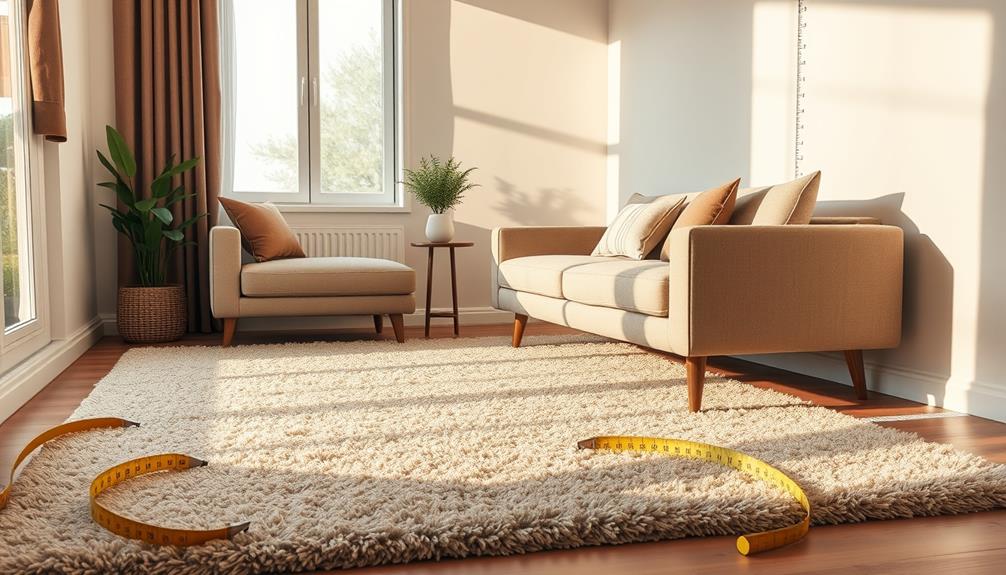
Accurate measurements are essential to ascertain your new sofa fits perfectly in your living space. Start by measuring your room dimensions. Ideally, the sofa length should be about two-thirds of the room or wall length for balanced proportion.
Additionally, consider how home security systems can enhance safety in your space, as the presence of security systems deters 60% of potential burglars. Don't forget to measure everything, including the width of doorways, hallways, and any tight spaces your sofa must navigate. Allow for extra space for packaging, so you won't face any surprises on delivery day.
Next, consider the height in relation to your existing furniture. Measure the height of coffee tables or other nearby pieces to ascertain your sofa's seat height complements the overall arrangement. You want everything to flow well together.
Also, maintain at least 18 inches between the sofa and coffee table for comfortable movement and accessibility.
Testing Before You Buy
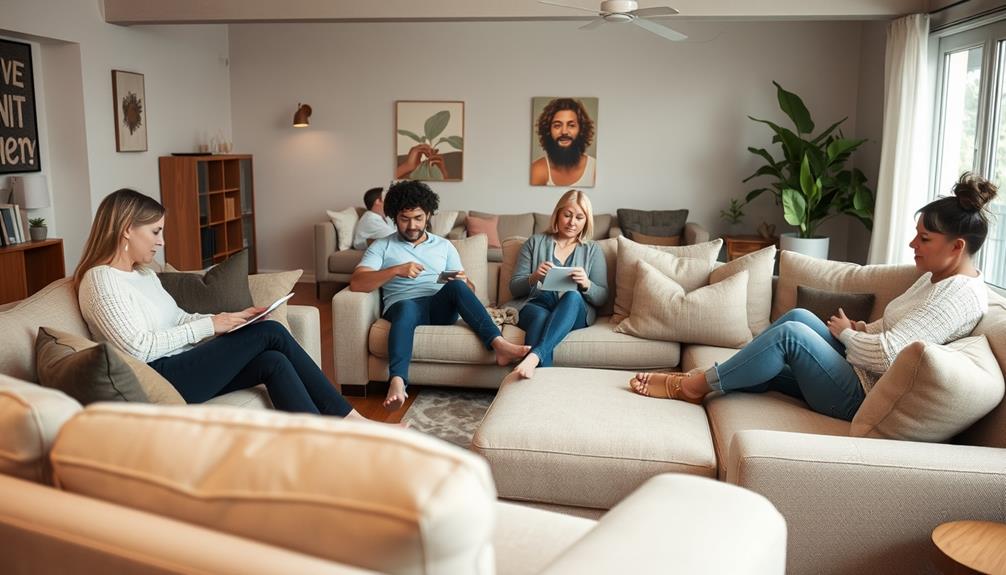
Before you make a final decision, visit local showrooms to try out different sofa styles and cushioning options.
It's also important to take into account how your environment affects your well-being; for instance, certain scents like essential oils for respiratory health can create a calming atmosphere while you test the sofas.
Spend at least 10-15 minutes sitting on each one to really feel the comfort and support.
Don't forget to check the return policy to guarantee you can test the sofa in your home for a week or more if needed.
Local Showroom Visits
Stepping into a local showroom is your chance to experience sofas up close and personal. You can test various styles and comfort levels, confirming you find the perfect fit for your needs before making a purchase.
Additionally, consider how furniture fits into your overall home setup, similar to how energy-efficient appliances can enhance your living space while saving costs.
While browsing, consider these key points:
- Try Before You Buy: Sit on different sofas to assess comfort and support.
- Know Your Space: Measure the dimensions on-site to confirm a good fit in your home.
- Engage with Staff: Ask for insights on materials, durability, and style options available to suit your lifestyle.
- Understand Return Policies: Check for any 30-day money-back guarantees and inquire about restocking fees or shipping costs if you decide to return a sofa.
Local showroom visits not only let you physically interact with the furniture but also provide peace of mind regarding return policies.
It's easier to visualize how a sofa will fit into your space when you can see it in person. Plus, the knowledgeable staff can guide you through the options available, helping you make an informed decision.
Don't underestimate the value of testing before you buy!
Home Testing Period
Testing a sofa in the comfort of your own home can make all the difference in ensuring it's the right choice for you. A home testing period allows you to experience the sofa in your space, helping you assess comfort and how well it fits your decor. Look for retailers that offer a trial period of 30 to 90 days.
Before you buy, check the return policy. Here's a quick comparison of common terms:
| Retailer | Home Testing Period | Restocking Fees |
|---|---|---|
| Retailer A | 30 days | Yes |
| Retailer B | 60 days | No |
| Retailer C | 90 days | Yes |
| Retailer D | 30 days | Yes |
| Retailer E | 45 days | No |
Don't forget to utilize this opportunity by testing the sofa with various activities like watching TV or hosting guests. This way, you can gauge its performance in real-life scenarios. Understanding the return policy is essential, as some retailers may charge fees for returns if the sofa doesn't meet your expectations during the home testing period.
Return Policies and Warranties

Understanding return policies and warranties is essential when choosing a sofa. Before making your purchase, take the time to investigate the manufacturer's return policy. Typically, the return window ranges from 30 to 90 days, so knowing this helps you plan.
Some retailers may also impose a restocking fee, usually between 10-20% of the purchase price, so clarify this beforehand to avoid surprises.
Warranties are equally important. They often cover manufacturing defects, with coverage periods varying from one year to a lifetime. Familiarize yourself with the warranty terms, including what's covered and any exclusions.
Here are a few key points to reflect on:
- Check the time frame for returns and any associated fees.
- Understand what defects the warranty covers (e.g., frame, cushions).
- Investigate the reputation of the customer service for handling claims.
- Read reviews to guarantee a smooth process if you need to make a warranty claim.
Shopping Strategies and Tips
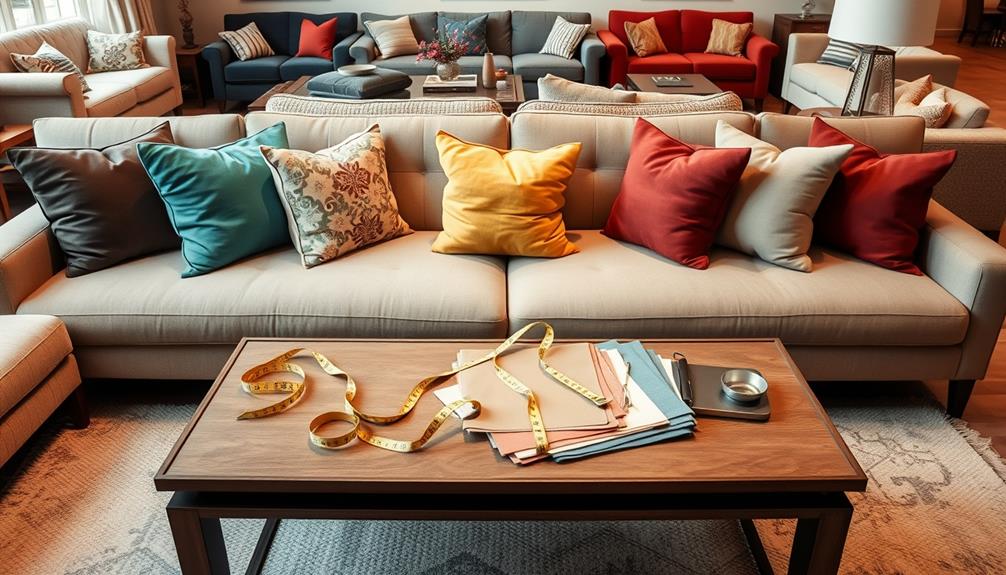
When shopping for a sofa, it's crucial to establish a clear budget right from the start, as prices can vary widely. Sofas can range from $700 to $2500, and luxury brands can exceed this. To make the most of your budget, consider these shopping strategies:
| Strategy | Description |
|---|---|
| Research Retailers | Check online and in-person stores like Wayfair and Joss & Main. |
| Compare Prices | Look for customer reviews to guarantee quality and value. |
| Use Promotional Codes | Take advantage of discounts during holidays or clearance sales. |
| Check Return Policies | Understand return policies to avoid unexpected costs. |
| Test Comfort | Visit local showrooms to experience the sofa firsthand. |
When you're buying a sofa, don't forget to explore various fabric options to find what fits your style and lifestyle. An affordable option may be available if you're willing to shop around. Always factor in shipping costs, as they can impact the total price. By applying these tips, you'll be well on your way to finding the perfect sofa that suits your needs and budget.
Frequently Asked Questions
How to Figure Out What Couch to Buy?
To figure out what couch to buy, assess your lifestyle needs, measure your space, and consider your home's decor. Evaluate construction quality and fabric options to guarantee comfort and durability for your household.
How Do I Choose a Sofa?
When you're traversing the labyrinth of choices, start by measuring your space. Consider your lifestyle, comfort needs, and budget, ensuring you find a sofa that'll not only fit but also elevate your home's heart.
What to Avoid When Buying a Sofa?
When buying a sofa, avoid poorly constructed frames, delicate fabrics unsuitable for your lifestyle, and excessively heavy pieces. Don't forget to sit on it first, and steer clear of overly cheap options that compromise quality.
How Can You Tell if a Sofa Is Good Quality?
Did you know that 80% of sofa buyers regret their purchase? To tell if a sofa's quality is good, check the frame, joinery, upholstery, suspension, and cushion fill—these factors greatly impact durability and comfort.
Conclusion
As you settle into your new sofa, picture the warm glow of evening light spilling over soft cushions, inviting friends to gather and share laughter. Choosing the perfect sofa is more than just a purchase; it's about creating a cozy sanctuary that reflects your style and fits your space. So take your time, trust your instincts, and let your imagination guide you. Soon, you'll have a stunning centerpiece that transforms your living area into a welcoming haven.
